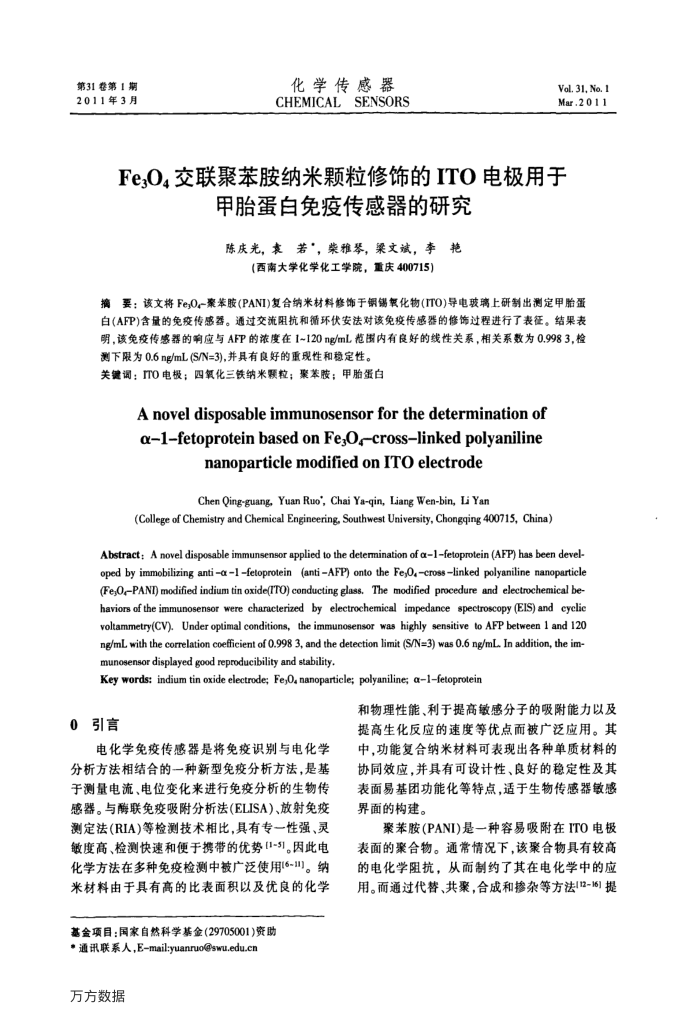Fe3O4交联聚苯胺纳米颗粒修饰的ITO电极用于甲胎蛋白免疫传感器的研究
内容简介
 第31卷第1期 2011年3月
第31卷第1期 2011年3月化学传感器 CHEMICALSENSORS
Vol. 31, No. 1 Mar.2011
Fe.O4交联聚苯胺纳米颗粒修饰的ITO电极用于
甲胎蛋白免疫传感器的研究陈庆光,衰若,,柴雅琴,梁文斌,李
艳
(西南大学化学化工学院,重庆400715)
摘要:该文将Fe;O-案苯胺(PANI)复合纳米材料修饰于铜锡氧化物(TTO)导电玻璃上研制出测定甲胎蛋白(AFP)含量的免疫传感器。通过交流阻抗和循环伏安法对该免疫传感器的修饰过程进行了表征。结果表明,该免疫传感器的响应与AFP的浓度在1~120ng/mL范围内有良好的线性关系,相关系数为0.9983,检
测下限为0.6ng/mL(S/N=3),并具有良好的重现性和稳定性。关键调:TTO电极;四氧化三铁纳米颗粒;聚苯胺;甲胎蛋白
Anoveldisposableimmunosensorforthedeterminationof α-1-fetoproteinbasedonFe.O-cross-linkedpolyaniline
nanoparticlemodifiedonITOelectrode Chen Qing-guang, Yuan Ruo', Chai Ya-qin, Liang Wen-bin, Li Yan
(College of Chemistry and Chemical Engineering, Southwest University, Chongqing 400715, China)
Abstract: A novel disposable immunsensor applied to the detemination of α1fetoprotein (AFP) has been devel-oped by immobilizing antiα 1 fetoprotein (anti AFP) onto the Fe,O,cross linked polyaniline nanoparticle(Fe;O,PANI) modified indium tin oxide(ITO) conducting glass, The modified procedure and electrochemical be haviors of the immunosensor were characterized by electrochemical impedance spectroscopy (EIS) and cyclic voltammetry(CV), Under optimal conditions, the immunosensor was highly sensitive to AFP between 1 and 120 ng/mL with the correlation coefficient of 0.998 3, and the detection limit (S/N=3) was 0.6 ng/mL. In addition, the im-munosensor displayed good reproducibility and stability
Key words: indium tin oxide electrode; Fe,O, nanoparticle; polyaniline; aα1fetoprotein
0引言
电化学免疫传感器是将免疫识别与电化学分析方法相结合的一种新型免疫分析方法,是基于测量电流、电位变化来进行免疫分析的生物传感器。与酶联免疫吸附分析法(ELISA)、放射免疫测定法(RIA)等检测技术相比,具有专一性强、灵敏度高、检测快速和便于携带的优势(1-5]。因此电化学方法在多种免疫检测中被广泛使用16-1。纳米材料由于具有高的比表面积以及优良的化学
基金项目:国家自然科学基金(29705001)资助*通讯联系人,Email:yuanruo@swu.edu.cn
万方数据
和物理性能、利于提高敏感分子的吸附能力以及提高生化反应的速度等优点而被广泛应用。其中,功能复合纳米材料可表现出各种单质材料的协同效应,并具有可设计性、良好的稳定性及其表面易基团功能化等特点,适于生物传感器敏感界面的构建。
聚苯胺(PANI)是一种容易吸附在ITO电极表面的聚合物。通常情况下,该聚合物具有较高的电化学阻抗,从而制约了其在电化学中的应用。面通过代替、共案,合成和掺杂等方法12-16]提